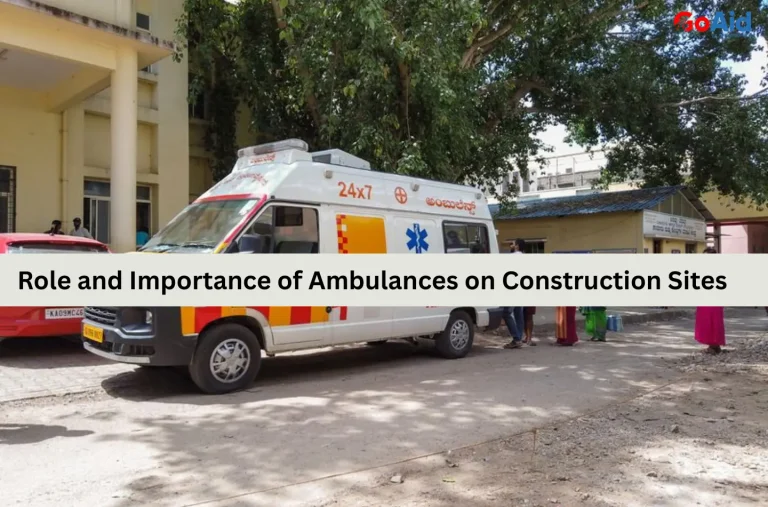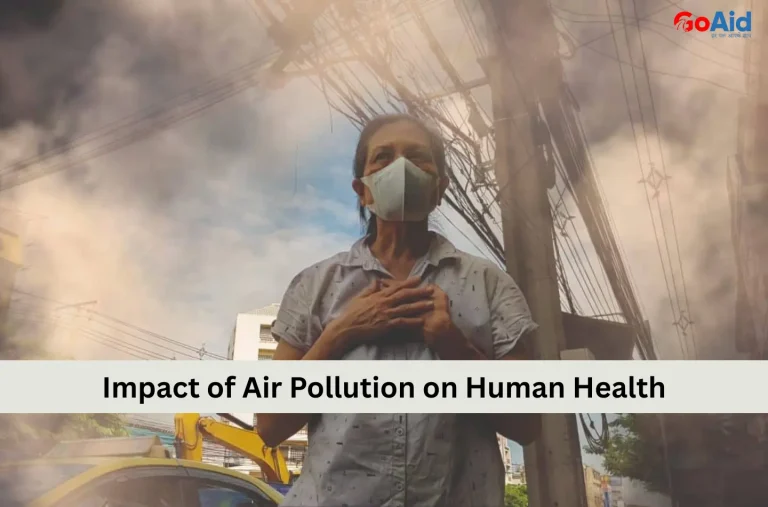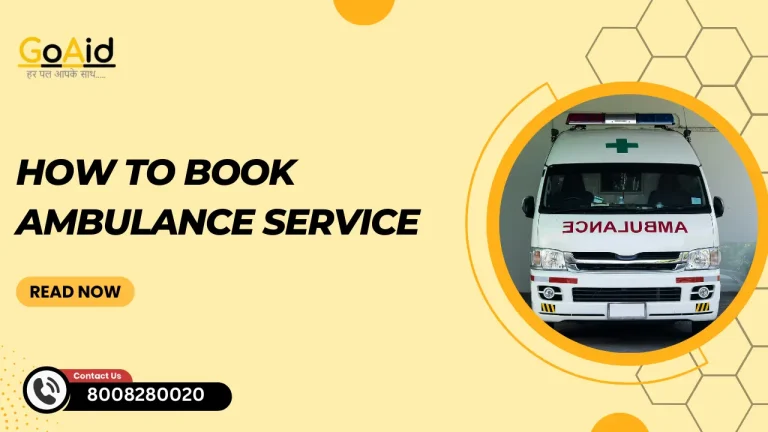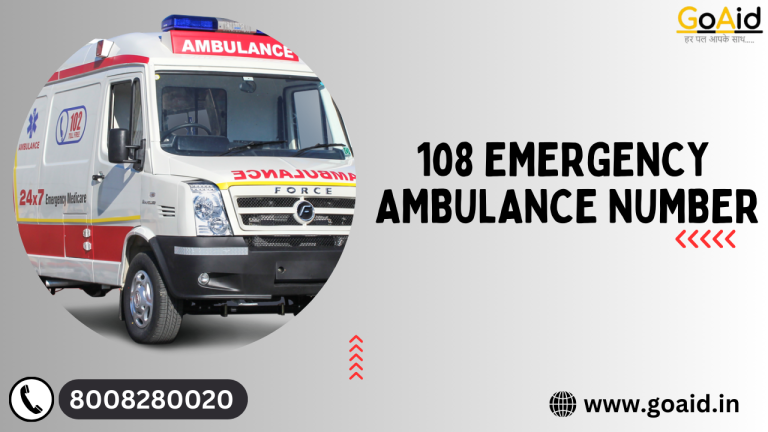In India & many other parts of the world, Old Age Homes & Rehabilitation Centers operate in huge numbers. At many reputed old-age homes, we can notice the on-site ambulance deployed on the campus of these centers. They are one of the most vulnerable locations that always remain in a huge medical emergency and need an on-site ambulance deployed 24/7. Still, there are many old-age homes and rehabilitation centers out there who does not consider to deploy an ambulance for the safety and security of old-age persons and people with unusual behavior or addictions.┬Ā
This is why, in this blog, we have provided complete details about why old-age homes and rehabilitation centers in India need the onsite ambulances deployed 24/7. WeŌĆÖve explained the status of these old-age homes and rehabilitation centers in India, common health and safety problems at these centers, why ambulances are essential for them and current problem and their solutions in providing ambulances at these centers and more. Are you excited to know all these details? Then read this blog to the end.
So, letŌĆÖs start-
Overview of the Old Age Homes & Rehabilitation Centers in India
Old age homes and rehabilitation centers in India have grown significantly, addressing the needs of a rapidly aging population and individuals requiring long-term recovery or support. These centers provide shelter, daily care, and specialized services for senior citizens and those with disabilities or chronic illnesses.
Many reputable facilities now prioritize ambulances for old age homes and ambulance for rehabilitation centers, ensuring timely medical attention during emergencies. However, access remains uneven, with numerous centers lacking dedicated on-site ambulance for elderly care, leaving residents vulnerable during medical crises.┬Ā
The government and regulatory bodies have set minimum standards for medical care, including arrangements with nearby hospitals and the availability of ambulances with oxygen support. As awareness grows, more facilities are adopting GoAid Ambulance Service and similar providers to improve medical emergency in old age homes and guarantee safe patient transfer from old age homes. This shift is vital for enhancing emergency care for elderly and disabled residents.
Common Health & Safety Problems at Old Age Homes & Rehabilitation Centers
Old age homes and rehabilitation centers face a range of health and safety challenges due to the vulnerability of their residents. Addressing these issues is essential for ensuring quality emergency care and overall well-being.
1. Chronic Diseases
Residents often suffer from chronic conditions such as cardiovascular illnesses, diabetes, and hypertension, making the presence of an ambulance in old age homes crucial for timely intervention during medical emergencies.
2. Mobility and Fall Risks
Limited mobility and frailty make elderly residents prone to falls and fractures. On-site ambulance for elderly care ensures rapid response and safe transfer to medical facilities for injury management.
3. Mental Health Disorders
Depression, anxiety, and dementia are prevalent, often exacerbated by isolation and lack of family support. Geriatric emergency response is needed for psychiatric crises and behavioral emergencies.
4. Vision and Hearing Impairments
A significant proportion of residents experience vision and hearing loss, increasing their risk of accidents, and making first aid in old age homes vital for immediate care.
5. Respiratory and Infectious Diseases
Conditions like asthma, respiratory infections, and seasonal flu spread easily in communal settings. Ambulance for senior citizens is critical for quick isolation and hospital transfer during outbreaks.
6. Neglect and Abuse
Instances of neglect, abuse, or inadequate care can lead to both physical and psychological harm. Emergency care for the elderly is essential to address such incidents swiftly and safely.
7. Medication Management Issues
Polypharmacy and improper medication administration can result in adverse drug reactions or overdoses. Ambulance support for nursing homes helps manage such emergencies and ensures safe patient transfer from old-age homes
The Risky Nature of Old Age Homes & Rehabilitation Centers
Old age homes and rehabilitation centers in India cater to some of the most vulnerable segments of societyŌĆösenior citizens and individuals with chronic illnesses or disabilities. These facilities house residents with multiple comorbidities, limited mobility, and complex care needs, making them highly susceptible to medical emergencies and accidents.
The risk is compounded by the prevalence of age-related conditions such as dementia, depression, and sensory impairments, which can lead to confusion, falls, and behavioral crises. Many centers struggle with inadequate infrastructure, limited accessibility, and a shortage of trained staff, further elevating the risk of adverse events.
Infections, dehydration, pressure ulcers, and medication errors are common, especially in crowded or poorly supervised environments. The lack of robust regulatory oversight and standardized care protocols can result in inconsistent quality and safety standards, leaving residents exposed to neglect, abuse, and delayed emergency response. Ensuring comprehensive emergency care is thus a critical challenge for these institutions.
Current Problems Faced
Despite their importance, old age homes and rehabilitation centers in India face a host of persistent problems that compromise resident safety and well-being. Many facilities operate with limited resources, resulting in inadequate infrastructure, insufficient medical equipment, and a lack of wheelchair-accessible designs.┬Ā
Staff shortages and insufficient training in geriatric care lead to suboptimal monitoring and delayed response to emergencies. The absence of clear regulations and standardized healthcare protocols creates wide disparities in service quality across different centers. Elder abuse, neglect, and poor incident reporting mechanisms remain significant concerns, often going unaddressed due to fear of reputational damage or lack of oversight.
Residents frequently experience isolation, depression, and anxiety, with mental health needs often overlooked or inadequately managed. Financial constraints, unclear property rights, and social stigma further hinder the ability of seniors to access quality care. These challenges highlight the urgent need for robust emergency care systems, including reliable ambulance services, in these settings.
Why Ambulance Services Are Essential for Old Age Homes & Rehabilitation Centers?
A dedicated ambulance service is vital for old age homes and rehabilitation centers due to the high vulnerability of their residents and the complexity of their care needs.
- Rapid Medical Response: Immediate ambulance access ensures timely intervention during medical emergencies, reducing the risk of complications or fatalities.
- Specialized Elderly Care: Ambulances for senior citizens are equipped to handle age-related conditions such as falls, strokes, or cardiac events.
- Safe Patient Transfers: Reliable ambulance support for nursing homes ensures safe transportation to hospitals or specialist clinics for further treatment.
- Mental Health Crisis Management: Geriatric emergency response teams can address psychiatric or behavioral emergencies, minimizing harm to residents and staff.
- Compliance and Trust: On-site ambulance for elderly care demonstrates a commitment to safety, enhancing the reputation and regulatory compliance of the facility.
Types of Ambulance Services Might be Required in the Old Age Homes & Rehabilitation Centers
Old age homes and rehabilitation centers require a variety of ambulance services to address the unique health and mobility needs of their residents. Here are five essential types:
1. Basic Life Support (BLS) Ambulance
A BLS ambulance for old age homes is equipped with essential medical devices, oxygen, and trained staff to provide immediate care for non-critical emergencies. It is ideal for stabilizing elderly patients, administering first aid, and ensuring safe transport to hospitals for further evaluation or treatment.
2. Advanced Life Support (ALS) Ambulance
An ALS ambulance for rehabilitation centers comes with advanced equipment like cardiac monitors, ventilators, and life-saving medications. Staffed by paramedics, it is crucial for handling severe medical emergencies such as cardiac arrests, strokes, or respiratory distress among elderly or disabled residents.
Also Read: Difference between BLS Ambulance and ALS Ambulance
3. Wheelchair Ambulance
A wheelchair ambulance for the disabled and elderly is specially designed for residents with minor mobility issues. It features easy-access ramps, secure seating, and safety features, ensuring comfortable and safe transfers for those who do not require a stretcher but need assistance.
4. Stretcher Ambulance
A stretcher ambulance for patient transfer from old age homes is tailored for residents who cannot sit upright due to fragile health or injury. It provides a flat-bed facility, basic medical care, and gentle handling during transfers between centers, hospitals, or homes.
5. Mobile Intensive Care Unit (MICU) Ambulance
A MICU ambulance for geriatric emergency response is a fully equipped ICU on wheels, staffed by a specialized medical team. It offers critical care interventions, such as cardiac monitoring and ventilator support, for transporting critically ill elderly or rehabilitation patients requiring constant monitoring.
Current Challenges in Providing Ambulance Services to Old Age Homes & Rehabilitation Centers
Old age homes and rehabilitation centers face unique and persistent challenges in ensuring timely and effective ambulance services for their vulnerable residents, impacting emergency care and patient outcomes.
1. Traffic Congestion:
Ambulance response is often delayed by heavy urban traffic, especially in cities, critically affecting timely medical intervention for elderly or disabled patients during emergencies.
2. Limited Funding:
Many centers struggle with inadequate financial resources, restricting the ability to acquire advanced ambulances, maintain vehicles, and provide comprehensive staff training, ultimately impacting service quality.
3. Staff Shortages:
A shortage of qualified emergency medical technicians (EMTs) and paramedics increases workloads, fatigue, and reduces the effectiveness of emergency response at these facilities.
4. Poor Maintenance and Equipment:
Outdated or malfunctioning medical equipment and vehicles compromise patient care and can pose significant risks during emergency medical interventions.
5. Geographical Barriers:
Remote or rural locations often have poor infrastructure, making it difficult for ambulances to reach patients quickly, especially during critical emergencies.
6. Communication Issues:
Inefficient communication systems hinder coordination between ambulance crews, dispatch centers, and hospitals, delaying critical care for elderly and disabled residents.
7. High Call Volumes:
An overwhelming number of emergency calls can strain limited resources, leading to longer response times and potentially impacting the quality of patient care.
8. Inadequate Training:
Insufficient or outdated training programs for EMTs and paramedics mean staff may not be fully equipped to handle the variety of emergencies encountered in elderly care.
9. Regulatory Compliance:
Navigating complex regulations and maintaining compliance requires substantial administrative effort, which can be burdensome for resource-limited centers.
10. Delayed Response Time:
Ambulances often face delays due to poor road infrastructure, inefficient dispatch systems, and lack of coordination among emergency stakeholders, affecting outcomes for critical patients.
The Right Solution ŌĆō On-site Ambulance Services for Old Age Homes & Rehabilitation Centers
Implementing dedicated on-site ambulance services is the most effective way to overcome these challenges, ensuring rapid emergency response and improved care for elderly and disabled residents.
1. Strategic Ambulance Placement:
Station ambulances within or near old age homes and rehabilitation centers to minimize response time and ensure immediate medical care for residents in emergencies.
2. Securing Additional Funding:
Utilize government grants, public-private partnerships, and efficient budgeting to enhance resources for ambulance services and staff training.
3. Recruitment and Training:
Offer competitive salaries and continuous education to attract and retain skilled EMTs and paramedics, ensuring high-quality emergency care.
4. Regular Equipment Maintenance:
Implement strict maintenance schedules and invest in reliable, modern equipment to guarantee functional ambulances and medical devices.
5. Advanced Communication Systems:
Upgrade to digital radios and mobile data terminals, and establish standardized protocols for efficient communication between facilities, ambulances, and hospitals.
6. Flexible Staffing and Fleet Expansion:
Expand ambulance fleets and staff during peak times, and implement triage systems to prioritize calls and manage high volumes effectively.
7. Continuous Staff Education:
Partner with educational institutions for specialized training in geriatric emergency response and regularly update staff skills and protocols.
8. Compliance Management:
Assign compliance officers to keep ambulance operations aligned with all health and safety regulations, reducing administrative burden and legal risks.
9. Technology Integration:
Adopt GPS, real-time tracking, and digital booking systems to streamline dispatch, improve response times, and enhance transparency.
10. Community and Stakeholder Engagement:
Raise awareness among residents, families, and staff about the importance of on-site ambulance services and foster collaboration with local healthcare providers for seamless care transitions.
Future of Emergency Medical Services in Old Age Homes & Rehabilitation Centers
The future of emergency medical services in old age homes and rehabilitation centers will be shaped by technology, specialized care, and growing awareness of elderly’s needs. Facilities are expected to adopt telemedicine, AI-driven monitoring, and advanced communication tools for faster emergency detection and response.┬Ā
On-site ambulances equipped with ICU, oxygen, and geriatric care features will become standard, ensuring immediate intervention during health crises. Partnerships with professional ambulance providers will offer scalable solutions for both urban and rural centers.┬Ā
Staff will receive regular training in emergency protocols and mental health care, addressing the complex needs of elderly and disabled residents. As regulations tighten and expectations rise, robust EMS integration will be essential for safety, compliance, and resident trust, making advanced ambulance support a core part of elderly and rehabilitation care.
Legal Obligation for On-Site Ambulances in India for Old Age Homes & Rehabilitation Centers
In India, old age homes and rehabilitation centers are increasingly required to ensure timely emergency medical support as part of their operational standards. Regulatory frameworks, including guidelines from the Ministry of Social Justice and Empowerment, recommend on-site ambulance availability or formal tie-ups with ambulance providers for immediate response.
Facilities caring for senior citizens or disabled individuals must have robust emergency protocols, including 24/7 ambulance access, especially in high-capacity or high-risk centers. Non-compliance can lead to penalties, reputational harm, or even closure.
Authorities also require regular staff training in first aid and emergency care, and clear documentation of patient transfer procedures. As public scrutiny grows, deploying on-site ambulances is not just a legal obligation but a mark of responsible care, enhancing trust among residents and their families while ensuring compliance with evolving healthcare standards.
How can GoAid be Used as a Reliable Partner for Rehabilitation Centers Ambulance Needs?
GoAid Ambulance Service is a leading provider of emergency and non-emergency medical transport for old age homes and rehabilitation centers across India. With a 10-minute response time, GoAid offers a wide range of ambulances, including BLS, ALS, ICU, and oxygen-equipped vehicles, tailored to the needs of elderly and disabled residents.
Their fleet is staffed by trained paramedics and medical professionals who understand the complexities of geriatric and rehabilitation care. GoAidŌĆÖs services are available 24/7, ensuring round-the-clock safety and peace of mind for residents and caregivers. Easy booking, transparent pricing, and strict hygiene protocols make GoAid the preferred choice for reliable, compassionate, and compliant ambulance support in these sensitive environments.
Benefits of Hiring GoAid Ambulances for Rehabilitation Centers
- 10-minute rapid ambulance response for emergencies
- Trained paramedics skilled in geriatric and rehab care
- Wide range of ambulances: BLS, ALS, ICU, and oxygen-equipped
- 24/7 availability, including nights and holidays
- Easy booking via phone, app, or website
- Transparent, government-approved pricing
- Strict sanitization and hygiene protocols
- GPS tracking for real-time ambulance location
- Seamless patient transfer between facilities
- National coverage, including urban and remote areas
Case Studies/Examples (Adani, Tata, Knight Frank)
GoAid Ambulance Service has become a trusted partner for major organizations in India and abroad. GoAid is currently tied up with Adani, providing on-site ambulances at their various old age homes, rehabilitation centers, and associated facilities, ensuring rapid emergency response and resident safety.
Similarly, GoAid collaborates with Tata, delivering specialized ambulance services tailored to the needs of their elderly care and rehabilitation projects. Internationally, GoAid extends its expertise to Knight Frank, a leading real estate company in the UK, supplying ambulance support for their residential and care properties.
These partnerships highlight GoAidŌĆÖs ability to deliver reliable, high-quality ambulance services for diverse healthcare and community environments, reinforcing its reputation as a leader in emergency medical support for vulnerable populations.
Conclusion to the Need of Ambulance Services in Old Age Homes & Rehabilitation Centers
In conclusion, the need for ambulance services in old age homes and rehabilitation centers is undeniable. These facilities house highly vulnerable populations who require immediate and specialized care during emergencies.
On-site ambulances ensure rapid response, safe patient transfers, and compliance with legal standards, significantly improving resident outcomes and peace of mind for families. GoAidŌĆÖs proven expertise, rapid deployment, and tailored solutions make it the ideal partner for centers seeking to enhance their emergency preparedness and uphold the highest standards of care for elderly and disabled residents.
Call-to-Action (CTA)
Ensure the safety and well-being of your residents with GoAidŌĆÖs affordable, reliable on-site ambulance services. Contact GoAid today for rapid emergency support and customized ambulance solutions for your old-age home or rehabilitation center.
FAQs on the Need for Ambulance Services in Old Age Homes & Rehabilitation Centers
Question-1: Why are ambulances needed at Old Age Homes & Rehabilitation Centers?
Answer: Ambulances for old age homes and rehabilitation centers ensure immediate emergency care for elderly and disabled residents, addressing medical emergencies and enabling safe patient transfer from old age homes to hospitals or clinics.
Question-2: What types of injuries are common in the Rehabilitation Centers?
Answer: Common injuries include falls, fractures, pressure sores, medication errors, respiratory distress, and cardiac events, all requiring rapid response from a rehabilitation center ambulance service and elder care medical transport.
Question-3: Is it mandatory to have ambulance services at Old Age Homes & Rehabilitation Centers in India?
Answer: Yes, Indian guidelines recommend on-site ambulance for elderly care or formal tie-ups for ambulance for old age homes, especially in high-capacity centers, to ensure compliance and prompt medical emergency response.
Question-4: Can private companies provide ambulance services to Old Age Homes & Rehabilitation Centers?
Answer: Yes, private providers like GoAid Ambulance Service offer specialized ambulance for rehabilitation centers and ambulance support for nursing homes, ensuring timely and professional geriatric emergency response.
Question-5: What should a Rehabilitation Center look for in an ambulance service provider?
Answer: Centers should seek ambulance for disabled and elderly with trained paramedics, 24/7 availability, proper equipment, transparent pricing, and experience in emergency care for elderly and patient transfer from old age homes.
Question-6: What is an on-site ambulance service?
Answer: On-site ambulance for elderly care means stationing ambulances at the facility, providing immediate first aid in old age homes and rapid transport during any medical emergency in old age homes.
Question-7: How does an ambulance service improve worker safety on Old Age Homes & Rehabilitation Centers?
Answer: Ambulance for senior citizens ensures quick intervention, reduces severity of incidents, and supports staff in managing emergencies, improving overall safety and confidence in the facility.
Question-8: Can ambulance services be customized based on the size of the project?
Answer: Yes, ambulance for old age homes and rehabilitation centers can be scaled and tailored for small or large facilities, matching resident needs and risk profiles.
Question-9: Are there any legal obligations for emergency medical support at Old Age Homes & Rehabilitation Centers?
Answer: Yes, regulations require emergency care for elderly, including ambulance with oxygen support, formal hospital tie-ups, and staff trained in first aid in old age homes to meet minimum standards.
Question-10: How much does it cost to hire an ambulance service for a construction project?
Answer: Costs for ambulance for old age homes or rehabilitation centers vary by service type, duration, and location, but many providers offer affordable, transparent pricing and government-approved rates.
Question-11: Do ambulance providers offer trained paramedics along with the vehicle?
Answer: Yes, reputable providers supply ambulance for senior citizens with skilled paramedics, ensuring quality emergency care for elderly and disabled residents.
Question-12: Can ambulances be equipped with trauma kits for construction-related injuries?
Answer: Absolutely, ambulance for rehabilitation centers can be equipped with trauma kits, oxygen, and advanced life support equipment for a wide range of emergencies, including falls or injuries.
Question-13: How fast can an on-site ambulance respond compared to city emergency services?
Answer: On-site ambulance for elderly care responds within minutes, far faster than city services delayed by traffic or distance, ensuring prompt geriatric emergency response.
Question-14: How does having an ambulance affect insurance and liability claims?
Answer: Having ambulance support for nursing homes improves compliance, reduces liability, and can positively impact insurance claims and premium rates by demonstrating proactive emergency care.
Question-15: Is a 24/7 ambulance service necessary for Old Age Homes & Rehabilitation Centers?
Answer: Yes, 24/7 ambulance for old age homes is essential due to unpredictable emergencies and the high vulnerability of elderly and disabled residents, ensuring constant safety and peace of mind.
















